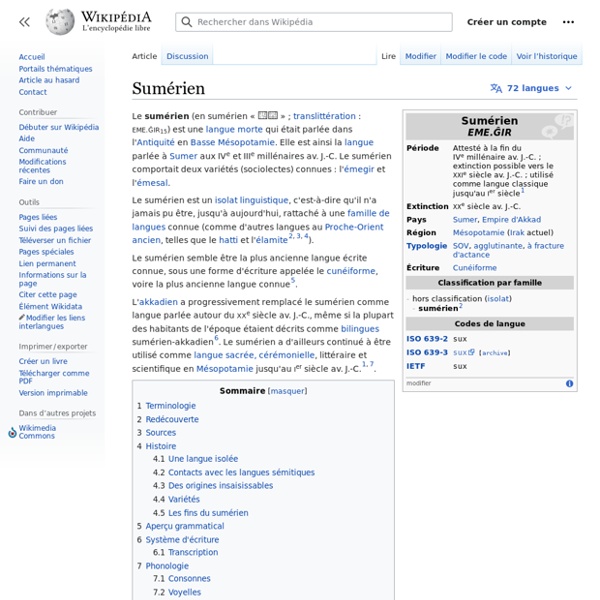Sumerian Mythology: Introduction
Sacred Texts Ancient Near East Index Previous Next p. 1 The study of Sumerian culture introduced by the present volume, Sumerian Mythology, is to be based largely on Sumerian literary sources; it will consist of the formulation of the spiritual and religious concepts of the Sumerians, together with the reconstructed text and translation of the Sumerian literary compositions in which these concepts are revealed. It is therefore very essential that the reader have a clear picture of the nature of our source material, which consists primarily of some three thousand tablets and fragments inscribed in the Sumerian language and dated approximately 1750 B. The decipherment of Sumerian differed from that of Accadian 3 and Egyptian in one significant detail, a detail p. 2 which proved to be one of the factors in hampering the progress of Sumerology to no inconsiderable extent. p. 3 p. 4 [paragraph continues] Layard was uncovering at Nineveh a large number of inscribed clay tablets. p. 5 p. 6 p. 7 p. 8
Les Sumériens
Ce qui caractérise l'organisation politique sumérienne, c'est son organisation 'à la grecque'. En effet, tout comme beaucoup plus tard la Grèce antique, le pays de Sumer était subdivisé en zones d'influence se structurant autour de quelques villes-phares, telles que Ur, Eridu, Lagash, etc...Ainsi, la société sumérienne reflétait une organisation où les villages se concentraient autour de villes plus grandes. Ces regroupements constituaient des zones d'influence ou cités-Etats. Chacune de ces villes possédait sa propre ziggourat. A) Introduction : B) L'histoire du sumérien et de son écriture : - Les plus vieux exemples d'écriture sumérienne datent d'environ 3000av JC (fin de l'époque proto-littéraire). - Vers 2300av JC déjà, le sumérien avait cessé d'être la langue prépondérante en Mésopotamie. Voici un tableau chronologique reflétant les 4 périodes de la langue sumérienne :
Timeline of World History - Category:History timelines — Wikimedia Commons
Sumer
Un article de Wikipédia, l'encyclopédie libre. Situation du Pays de Sumer Ayant été complètement oubliée après les débuts de notre ère, la civilisation de Sumer a été redécouverte durant la seconde moitié du XIXe siècle grâce aux fouilles de sites archéologiques du Sud mésopotamien, dont l'exploration s'est poursuivie par la suite, jusqu'à connaître un arrêt en raison des troubles politiques affectant l'Irak à partir des années 1990. En plus des redécouvertes architecturales et artistiques qui furent à plusieurs reprises remarquables, les fouilles ont permis la découverte de dizaines de milliers de tablettes inscrites en écriture cunéiforme, qui est la plus ancienne documentation écrite connue avec celle de l’Égypte antique. Sumer est donc l'une des plus anciennes civilisations historiques connues, ayant participé à la mise au point de ce système d'écriture durant les derniers siècles du IVe millénaire av. J. Conditions d'étude[modifier | modifier le code] Un peuple ? ↑ J. (de) Gebhard J.
Bible Maps, Timelines, Charts, Lineages
The Lost Tribes of Israel Locations where Israel taken captive View Migration after captivity View Israel's first settlement in Europe View The Roman Empire The Roman Empire at its Peak View Empire under Diocletian, Constantine View Rise and Fall of Rome's empire View Roman Empire in the First Century View Apostle Paul's Missionary Journeys All cities visited by Apostle Paul View Paul's travels after his conversion View Paul's FIRST Missionary Journey View His SECOND Journey View His THIRD Journey View His FOURTH Journey View Paul's LAST Missionary Journey View Area of Greatest Evangelistic Success View Maps of World Empires History's Greatest Empires See List The Roman Empire at its height View Alexander the Great's Empire View Assyrian and Babylonian Empires View Ancient Near East Empires View Persian Empire at its Height View Byzantine Empire in 1025 AD View Empire of Athens at its most powerful View Ottoman Empire at its Peak View Parthian Empire at its greatest extent View Biblical Family Trees World Maps
Jewish Timeline - a Brief History of the Jewish People in One Page
Greek Mythology: FAMILY TREE OF THE GREEK GODS
The complete family tree of the gods is displayed over eight indexed charts. The basic structure follows Hesiod's Theogony, but that author's genealogies have been expanded with a plethora of additional gods, spirits and creatures sourced from other classical sources. Where there is disagreement amongst ancient writers as to the genealogy of a certain character, the oldest and/or most popular source has been selected for the chart. An additional family tree depicts the divine genealogy given in Hesiod's Theogony. Click on any name in the chart to view the full page entry for that individual. INDEX Index of names in the family tree KEY Overview of and key to reading the charts CHART 0 The Main Gods A short tree containing just the main gods of the pantheon. CHART 1 The Cosmogony of the Gods The primordial gods or protogenoi. CHART 2 The Children of Night The spirit descendants of Khaos (Air), Nyx (Night) and Eris (Strife). CHART 4 The Children of Sea, Storm and Earth.
Greek Gods Family Tree
ludios.org
Free Online College Courses from Top Universities | Academic Earth
The Do It Yourself Scholar | Explore the best in free web learning.
Evernote
Google Drive - free online storage from Google
Dropbox
TinyScan - PDF scanner to scan document, receipt & notes



